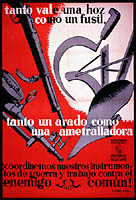 |
Tanto vale una hoz como un fusil, tanto un arado como una ametralladora. Coordinemos nuestros instrumentos de guerra y trabajo contra el enemigo común
[A sickle is as valuable as a rifle. A plough is as important as a machine-gun. Let's coordinate our tools of war and labor against the common enemy]. Signed: F. Pérez Mateo. Ministerio de Instrucción Pública. Dirección Gral. de Bellas Artes. Asociación de Obreros Litógrafos. Gráficas Reunidas, U.H.P. Madrid. Lithograph, 3 colors; 100 x 69 cm.
|
|
The need to combine military
and economic efforts in order to win the war is expressed in several
posters in this collection (posters 23, 24, 26). In this case, the
written message is echoed by the conjoining of weapons (represented
by a German-made Karabiner 98b rifle and a machine-rifle) and agricultural
tools. The appearance of instruments of labor and war together may
also be read as symbolic of the encroachment of the culture of war
upon everyday life, as happens to a civil population living through
a military confrontation for an extended period of time. A knowledge
of guns and other weaponry was probably as conspicuously absent
in Spain in the years before the war as it is today. This situation
gradually changed as the war took over the lives of citizens. Contemporary
newspapers and periodicals included abundant images of military-like
uniforms and military maps, representing a facet of life which was
rapidly becoming all too familiar for the readers. The appearance
of guns in this and similar posters also contributed to spreading
the culture of war.
This poster was issued
by the Ministry of Public Instruction, probably after Jesús
Hernández was appointed Minister on September 4, 1936. Since
the poster was printed in Madrid (as shown by the inscription on
the lower left corner of the image), it must date earlier than November
6, 1936, when the central government fled Madrid for Valencia. Also,
the author, Pérez Mateo, can probably be identified as Francisco
Pérez Mateo, an artist who died at the front on November
7 of that same year. Active on the Republican side during the first
months of the war, Pérez Mateo was known primarily as a sculptor,
a fact which makes this poster an oddity among his work. He was
born in Barcelona in 1903 and moved to Madrid in 1917, where he
studied at the Royal Academy of San Fernando. In 1925, Pérez
Mateo traveled to Paris, and in 1928 he held his first individual
exhibition and won the national prize for sculpture. Pérez
Mateo belonged to some of the leading artists' associations of the
time, such as the Sociedad de Artistas Ibéricos, and
he was included in an exhibition by this group in Paris in 1936.
In 1933 he participated in the first Exhibition of Revolutionary
Art in Madrid, which also included works by other artists in this
exhibition (Monleón, Renau and Rodríguez Luna). He
was a member of the Communist Party of Spain (PCE), and at the outbreak
of the war he enlisted in the communist Fifth Regiment, one of the
most famous combat units in the Republican army. Fighting as a lieutenant
with this regiment, Pérez Mateo was wounded in the defense
of Madrid on November 6, 1936, and died in the trenches the next
day. An exhibit in his honor was included in the Spanish Pavilion
in the International Exhibition in Paris, where Picasso's Guernica
was also shown. An echo of Pérez Mateo's knowledge of avant-garde
art may be seen in this scene: the manner in which the composition
rests at its base on a right angle is reminiscent of a compositional
device used often by cubist painters.
|




